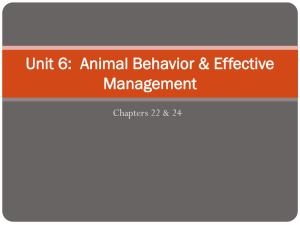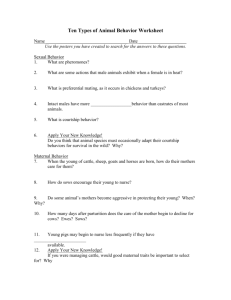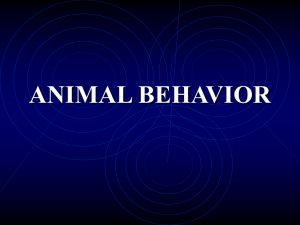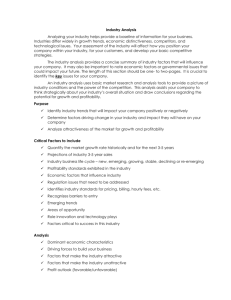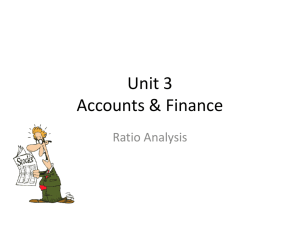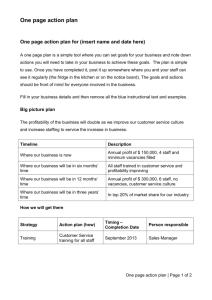Unit 4: Animal Behavior & Effective Management
advertisement
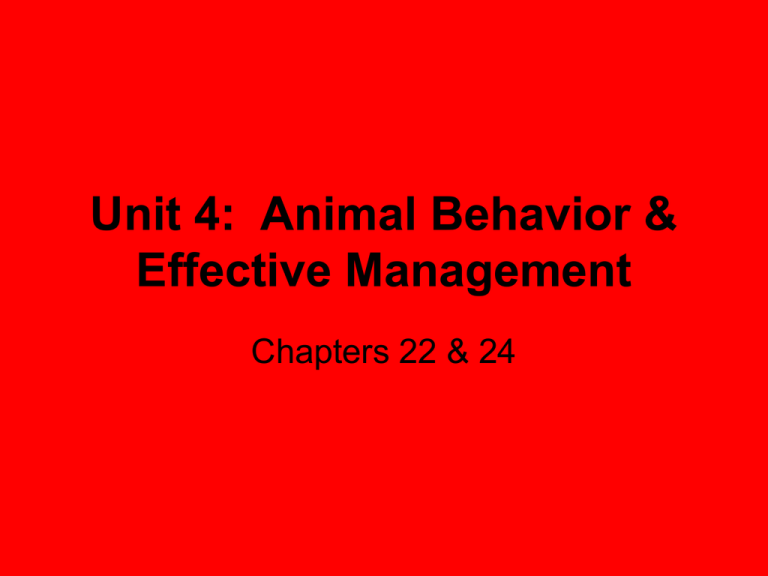
Unit 4: Animal Behavior & Effective Management Chapters 22 & 24 Unit 4: Animal Behavior & Effective Management • Unit 4 Objectives: – Knowledge of the affects of various animal behavior on production and performance – Appreciation of inherited vs. learned behaviors – Understanding of effective management, and its relationship to profit – Comprehension of the decision-making process, and technology/tools available to assist managers in the process Unit 4: Animal Behavior & Effective Management • Fields of Animal Behavior – Psychology – Ethology-Instinctive & Learned Behaviors • Instinct – Present @ birth (Ex. Nursing in mammals) • Habituation – Lack of response to a repeated stimulus – Called Conditioning » Classical-association between an unconditioned stimulus & a neutral stimulus (Pavlov’s Dogs) » Operant-learning to respond to a stimulus as a result of reinforcement Unit 4: Animal Behavior & Effective Management • Trial & Error – Trying different responses until the correct one is performed, tied to a reward • Reasoning – Correct response to a stimulus the first time – Intelligence » Short term memory » Long term memory • Imprinting – Bonding process – Mostly for recognition purposes Unit 4: Animal Behavior & Effective Management • Systems of Animal Behavior – Nine identified systems 1. 2. 3. 4. 5. 6. 7. 8. 9. Sexual Caregiving Care soliciting Agonistic Ingestive Eliminative Shelter seeking Investigative Allelomimetic Unit 4: Animal Behavior & Effective Management – Sexual Behavior – Heat or estrus – Pheromones – Used to attract the opposite sex – Flehman-curling of upper lip – Cow & Bull – Sow & Boar – Sow seeks out the boar – Mare & Stallion Unit 4: Animal Behavior & Effective Management – Caregiving Behavior • Most is maternally oriented • Stimulation to suckling • Protection – Care Soliciting Behavior • Young crying for help when distressed, disturbed, or hungry • Vocal sounds Unit 4: Animal Behavior & Effective Management – Agonistic Behavior • Fight or flight • Aggressive or passive • Interaction w/ other animals – Males always fight other strange males – Establishing social dominance » Offense » Defense » Escape » Passivity – Females usually are not as aggressive Unit 4: Animal Behavior & Effective Management • Social interaction plays a huge role in animal production – Age has an effect • Interaction w/ humans – Disposition is formed through experience and inheritance • Behavior during Handling & Restraint – Animals remember positive & negative experiences – All depends upon the handlers and the facilities – Knowing and understanding behavior will reduce stress on the producer and the animal, and prevent injury – Blood odor appears to be detectible Unit 4: Animal Behavior & Effective Management – Vision can be manipulated » Curves chute systems » Solid walls – Flight Zone Unit 4: Animal Behavior & Effective Management – Ingestive Behavior • Eating & drinking • Grazing behavior – – – – Rumination Relation to water access How do we manage the range Climate can have an impact on grazing – Eliminative Behavior • Feces and Urine – Cattle, sheep, goats are indiscriminate – Hogs will defecate in a particular area – Horses will defecate on the scent of another horse Unit 4: Animal Behavior & Effective Management • • • • Cattle defecate 12-18 times daily Horses defecate 5-12 Urinate ~7-11x/d Elimination is effected by stress – Responsible for Shrink Loss in cattle transport – Shelter-Seeking Behavior • Shade for rest & rumination • Wet areas for cooling • Crowding during cold conditions Unit 4: Animal Behavior & Effective Management – Investigative Behavior • Curiosity • Common in pigs, horses, dairy goats, and somewhat in cattle – Allelomimetic Behavior • Doing the same thing at the same time • Herding behavior Unit 4: Animal Behavior & Effective Management – Other Behaviors • Communication – Transfer of information through any of the senses • Maladaptive or Abnormal Behavior – Animals that cannot adopt to a new environment, or exhibit inappropriate behavior » Ex. Tail chewing and cannibalism in swine – Buller-steer syndrome » Steer castrated before puberty » Certain steers are more attractive for mounting » As one mounts, the others do the same » Can cause physical injury, reduced weight gain, additional labor/equipment » Can be as much as 1-3% of the feedlot steer herd Unit 4: Animal Behavior & Effective Management • Assignment for the first half of Unit 4 – Review questions • 2-5, 9, 11, 15, 18 Unit 4: Animal Behavior & Effective Management • Making Effective Management Decisions – Fixed resources • • • • Land Labor Capital Management – Renewable resources • Animals • Plants Unit 4: Animal Behavior & Effective Management • Managing for Lower Costs & Higher Returns – Profitability Formula • Profit/loss=(production X price) – cost – Production and cost include many different things • Managers should focus on the optimum level of output vs. input – Primary Components of Long-term profitability • Costs – Careful monitoring of input costs – Ex.? Unit 4: Animal Behavior & Effective Management • Production – Pounds or numbers sold • Price – Amount received/lb., or /h, or /doz. – Influenced by supply/demand • Resource Improvement – Land used for forage and cropping – Can easily be depleted if not cared for properly • So, how do producers focus on the business side of their operation? What can they influence? Unit 4: Animal Behavior & Effective Management • The Manager – Plan – Act – Evaluate – Characteristics of an Effective Manager • • • • • Profit-oriented Short-term and long-term objective planning Keep up on current knowledge/technology Effective time management Attentive to physical, emotional, financial needs of the employees Unit 4: Animal Behavior & Effective Management • Use of incentive programs for motivation • Honest business dealings • Effective communication and use of employee input • Prioritize duties • Self-starter • Prioritize resource use • Risk management • Be a good example Unit 4: Animal Behavior & Effective Management • Financial Management – Must have good records for costs, returns, and profitability • • • • • • • Cash transactions Balance Sheet (net worth=assets-liabilities) Income Statement Cash-flow Statement Enterprise Budget Partial Budget Income Tax Forms Unit 4: Animal Behavior & Effective Management – Credit and money management is crucial to making effect management decisions, during times of inflation & high interest rates • Credit must be managed carefully, and used as a tool • Income Tax Considerations – Paying little or no income tax should not be a goal – Well-managed operations pay income taxes if profitability is the goal • not poor management to pay income tax, but to pay more than is owed Unit 4: Animal Behavior & Effective Management • Estate & Gift-Tax Planning – Adequate knowledge & planning can greatly help managers pass on farms to heirs – Producers can make an annual gift of $10,000 to children/grandchildren without paying federal gift tax – 1997 unified credit exemption up to $1m by 2006 – 1998-family farms can use a family business exemption of an additional $300,000 – Consult a tax professional Unit 4: Animal Behavior & Effective Management • People – Most widely overlooked part of management, but is the most critical – Communication is the key – Effective people managers should be able to: • Determine optimum labor needs • Identify, hire, and retain employees • Motivate and reward employees both financially and nonfinancially • Keep the focus of the mission and goals • Build and enhance teams and partnerships Unit 4: Animal Behavior & Effective Management – If the operation is family-owned and operated • Use sound business practices • Evaluate other family operations • Include all family members in written planning of responsibilities • Weekly meetings for planning, evaluating, problem solving • Family relationships are most important, and can be compatible w/ profitability • Patience and tolerance • Encourage open communication Unit 4: Animal Behavior & Effective Management • Management Systems – Systematic organization of information in order to make valid management decisions – Critical thinking and assessment are key – Often, sophisticated evaluation tools are not necessary, however, they are useful for large volumes of information – Animal production has typically been maximized without consideration of costbenefit relationships Unit 4: Animal Behavior & Effective Management – Lets talk about some management examples, good or bad • Assignment for second half of Unit 4 – Review questions on pg. 437 – There’s only 3!
